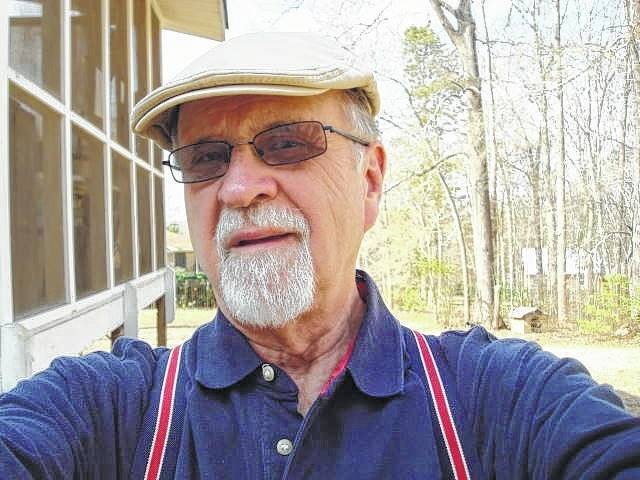Daddy laid his framing square on the 1×4 pine board, marked it with a flat pencil and proceeded to saw down the middle of the line, leaving graphite on each side. His hand saw cuts were always plumb, too, perhaps because he sawed gently, placing only three large fingers in the saw handle hole, leaving his index finger outside.
“Can you hear that?” he asked as he sawed.
“Sir?”
“Can you hear the saw?”
“Yes, sir. Buzz, buzz, buzz.”
“Not that,” he said. “Can you hear it sing?”
I listened to him sawing lots of times, and I tried lots of times myself, but I never heard a saw sing — that is until we used a two-man crosscut saw to cut down an oak tree. I would carry a kerosene can with a tater cap with one hand, and an empty Pepsi bottle with the other.
Daddy would bring the crosscut saw. He showed me the groups of inch-long teeth, rectangles with a v-cut in their tops, and sharp-tipped little H-shaped teeth on either side. Then we walked to the tree.
“Listen,” he said as the four-foot blade flexed across his shoulder. “Can you hear it singing?”
I could not.
When we got to the tree, Daddy took the Pepsi bottle, put a piece of longleaf pine top in its opening and flung kerosene all along the blade.
“Daddy, what’s the kerosene for?” I asked.
“To make it easy on the saw… keep the oak sap from grabbing it,” he said as he turned the saw over and wet the other side.
“Here,” he said, as he handed me my end of the saw.
I copied him, laying my end against the tree.
“Now don’t push, “ he said. “Just pull your end… all the way out. Then then let me pull my end all the way back.”
As I did that, the blade moved easily, but so-o-o slow. So I pushed.
“Nawk,” he said. “The saw doesn’t want to be pushed. You just pull.”
I just could not resist the desire to push. But every time I pushed I felt the saw drag. The saw was reacting to me, but it was not singing. Neither was Daddy.
“Quit, quit, ” Daddy said.
He stopped the saw and stood up.
“Son, do you like for someone to shove you?”
“No, sir.”
“Well, stop shoving the saw,” he said.”It’s just like you. If you shove it around, it will hold back. But it’ll cut like 40 saws if you treat it the way you want to be treated.”
And it will sing.
After a while, I tried holding the handle with just three fingers, the way daddy held his handsaw. And when I let daddy pull… I heard that little whing…
“That’s the blade singing,” Daddy smiled.
And as the saw sang, the sawdust just flew. I stopped pushing, so we could treat it the way it wanted to be treated, and the saw kept singing.
After we finished cutting wood and put the kerosene bottle and the crosscut away, Daddy took down his hand saw.
“Step over here and listen to this,” he said. Holding the saw by the handle, he tapped the blade with his knuckle.
“Did you hear that?”
I did, a little high-pitched ring.
“Now listen to this.”
He held the saw by the handle and tip, and had me tap it. It rang just like when he hit it. But the next time I hit the blade, he flexed it.
Then — wa-ing — the pitch changed. Later, I found out if you wiggled the end of the saw real fast as your sister hit it with a stick, it went boi- oi- oing, like Froggie playing his magic twanger for Smiling Ed McConnell. That sound made us laugh.
Daddy said we could play music on his saw if we had a bow to drag across the blade. Just like a bow could draw music out of a violin string, it could draw music out of a saw. We might have tried bowing a saw, if we had had a bow, but we didn’t. So I decided musical saws wouldn’t make much more music than a twanger anyway, and soon forgot the matter completely.
Daddy was long gone before I ever heard anyone play a handsaw. Then, the musician held the saw handle between his knees, while bending its small end with his left thumb and fingers. But he shoved the bow over the top of the saw like he was jooging an ox, and his saw responded like it was being so treated. Finally, this past week, I found a video of a sawyer playing, “Ave Maria.” Believing that tune would provide the ultimate test of the saw’s music, I watched the performance.
Austin Blackburn held his saw handle just like the jooger, and flexed the blade the same way, except he used a wooden handle instead of his fingers. But he played differently. As if he and his saw had all the time in the world to complete “Ave Maria,” he flexed the saw into an S-shape and gently applied the bow. As he changed the shape of the saw, it sang with the sound of a bell, but was so full and flowing, so ethereal, and, yes, so heavenly, that I first listened in disbelief, and then was moved to tears.
I remembered what Daddy showed me: “If you treat a saw like you want to be treated, it will sing.”
That goes for people, too.
Leon Smith, a resident of Wingate who grew up in Polkton, believes the truth in stories and that his native Anson County is very near the center of the universe.

